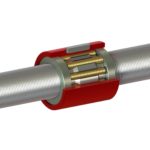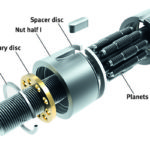Answer: You get a planetary roller screw.
Replacing the recirculating balls of a ball screw with grooved rollers results in a precision drive mechanism with extremely high load capacity, acceleration, and speed capabilities, all in a small footprint. Planetary roller screws fit well in applications at the upper end of ball screw capabilities, but that require speeds or positioning accuracy outside the range of hydraulic actuators. But how do planetary roller screws actually work? To find out, let’s dissect their name, starting from the end:
Screw: A planetary roller screw consists of a precision threaded screw and nut, similar to a ball or lead screw assembly. The screw and nut have a 90 degree thread profile, with multiple starts to accommodate the rollers.
Roller: Rather than recirculating balls, the load-bearing elements of a planetary screw are threaded rollers. The rollers have the same thread profile as the nut, and provide many more contact points for a given size than can be achieved when balls are used as the load-bearing elements.
Planetary: The ends of the rollers are toothed and mesh with geared rings at each end of the nut. Proper spacing of the rollers is ensured by guide rings that support the rollers’ end journals. This allows the rollers (also called planets) to orbit the nut as they spin on their axes, hence the term planetary.
![By User:Catsquisher (User:Catsquisher Transferred from en.wikipedia) [Public domain], via Wikimedia Commons Planetary Roller Screw Timing](http://upload.wikimedia.org/wikipedia/commons/2/24/Roller_Screw_Timing.gif)
![By User:Catsquisher (User:Catsquisher Transferred from en.wikipedia) [Public domain], via Wikimedia Commons Planetary Roller Screw](http://upload.wikimedia.org/wikipedia/commons/4/41/Roller_Screw.gif)
Because the basic motion principle is the same for both ball screws and planetary roller screws, sizing and selection is virtually identical for the two drive units. Bearing life, critical and max permissible speeds, buckling load, and required torque equations are all the same or use the same underlying principles. This makes designing for planetary roller screws as easy as designing for ball screws.
Why use a planetary roller screw instead of a ball screw?
The higher number of contact points inherent in the design of planetary roller screws gives them a much greater load capacity than ball screws, making them best suited for applications with very high loads or duty cycles, which present a challenge for traditional ball screws. The large number of contact points also reduces deflection and provides the same or better positioning accuracy as ball screws. The lack of recirculating elements in planetary roller screws allows them to achieve higher speeds and accelerations, and eliminates a common failure point often found with ball screws.
Additional benefits of planetary roller screws include lower friction and reduced noise, both a result of guided rollers that do not make contact with each other, unlike the balls in a ball screw. And the noise that is generated by planetary roller screws doesn’t increase with speed, making them much more quiet than ball screws in high speed applications.
Why use a planetary roller screw instead of a hydraulic actuator?
Compared to hydraulic cylinders and actuators, the main advantage of planetary roller screws is their lack of hydraulic fluid. This means less maintenance, no environmental issues from the fluid, and a simpler overall system, since there are no valves, pumps, or filters required for planetary roller screws. From a performance standpoint, planetary roller screws also offer better positioning accuracy and higher efficiency than hydraulic actuators.
To recap, a planetary roller screw is a screw assembly that uses rollers instead of balls. The rollers are threaded to allow movement along the length of the screw, and are geared to spin as the nut turns, eliminating the need for recirculation.
Whether comparing them to ball screws or to hydraulic actuators, planetary roller screws can provide higher performance in a smaller footprint, with lower maintenance and operating costs.
Featured image credit NOOK Industries






Leave a Reply
You must be logged in to post a comment.